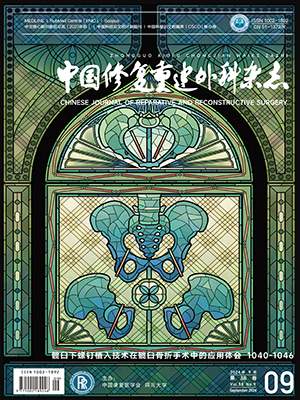| 1. |
Ng M, Fleming T, Robinson M, et al. Global, regional, and national prevalence of overweight and obesity in children and adults during 1980-2013: a systematic analysis for the Global Burden of Disease Study 2013. Lancet, 2014, 384(9945): 766-781.
|
| 2. |
Gillespie GN, Porteous AJ. Obesity and knee arthroplasty. Knee, 2007, 14(2): 81-86.
|
| 3. |
Anderson JJ, Felson DT. Factors associated with osteoarthritis of the knee in the first national Health and Nutrition Examination Survey (HANES Ⅰ). Evidence for an association with overweight, race, and physical demands of work. Am J Epidemiol, 1988, 128(1): 179-189.
|
| 4. |
Xia Z, Liow MHL, Goh GS, et al. Body mass index changes after unicompartmental knee arthroplasty do not adversely influence patient outcomes. Knee Surg Sports Traumatol Arthrosc, 2018, 26(6): 1691-1697.
|
| 5. |
Willis-Owen CA, Brust K, Alsop H, et al. Unicondylar knee arthroplasty in the UK National Health Service: an analysis of candidacy, outcome and cost efficacy. Knee, 2009, 16(6): 473-478.
|
| 6. |
赵东方, 孔祥朋, 王毅, 等. 第三代 Oxford 单髁假体安放位置对人工单髁关节置换术近期疗效的影响. 中国修复重建外科杂志, 2018, 32(12): 1518-1523.
|
| 7. |
王方兴, 薛华明, 马童, 等. 人工单髁关节置换术治疗超高龄膝关节骨关节炎患者的近期疗效. 中国修复重建外科杂志, 2019, 33(8): 947-952.
|
| 8. |
Xing Z, Katz J, Jiranek W. Unicompartmental knee arthroplasty: factors influencing the outcome. J Knee Surg, 2012, 25(5): 369-373.
|
| 9. |
WHO Expert Consultation. Appropriate body-mass index for Asian populations and its implications for policy and intervention strategies. Lancet, 2004, 363(9403): 157-163.
|
| 10. |
Kozinn SC, Scott R. Unicondylar knee arthroplasty. J Bone Joint Surg (Am), 1989, 71(1): 145-150.
|
| 11. |
Kandil A, Werner BC, Gwathmey WF, et al. Obesity, morbid obesity and their related medical comorbidities are associated with increased complications and revision rates after unicompartmental knee arthroplasty. J Arthroplasty, 2015, 30(3): 456-460.
|
| 12. |
Bonutti PM, Goddard MS, Zywiel MG, et al. Outcomes of unicompartmental knee arthroplasty stratified by body mass index. J Arthroplasty, 2011, 26(8): 1149-1153.
|
| 13. |
Cavaignac E, Lafontan V, Reina N, et al. Obesity has no adverse effect on the outcome of unicompartmental knee replacement at a minimum follow-up of seven years. Bone Joint J, 2013, 95-B(8): 1064-1068.
|
| 14. |
van der List JP, Chawla H, Zuiderbaan HA, et al. The role of preoperative patient characteristics on outcomes of unicompartmental knee arthroplasty: A meta-analysis critique. J Arthroplasty, 2016, 31(11): 2617-2627.
|
| 15. |
王方兴, 薛华明, 马童, 等. 单髁关节置换术治疗中重度肥胖膝前内侧骨关节炎患者的近期疗效分析. 中国骨与关节杂志, 2019, 8(4): 249-254.
|
| 16. |
Venkatesh HK, Maheswaran SS. Age and body mass index has no adverse effect on clinical outcome of unicompartmental knee replacement-midterm followup study. Indian J Orthop, 2019, 53(3): 442-445.
|
| 17. |
Woo YL, Chen YQ, Lai MC, et al. Does obesity influence early outcome of fixed-bearing unicompartmental knee arthroplasty? J Orthop Surg (Hong Kong), 2017, 25(1): 2309499016684297.
|
| 18. |
Xu S, Lim WJ, Chen JY, et al. The influence of obesity on clinical outcomes of fixed-bearing unicompartmental knee arthroplasty: a ten-year follow-up study. Bone Joint J, 2019, 101-B(2): 213-220.
|
| 19. |
Molloy J, Kennedy J, Jenkins C, et al. Obesity should not be considered a contraindication to medial Oxford UKA: long-term patient-reported outcomes and implant survival in 1000 knees. Knee Surg Sports Traumatol Arthrosc, 2019, 27(7): 2259-2265.
|




